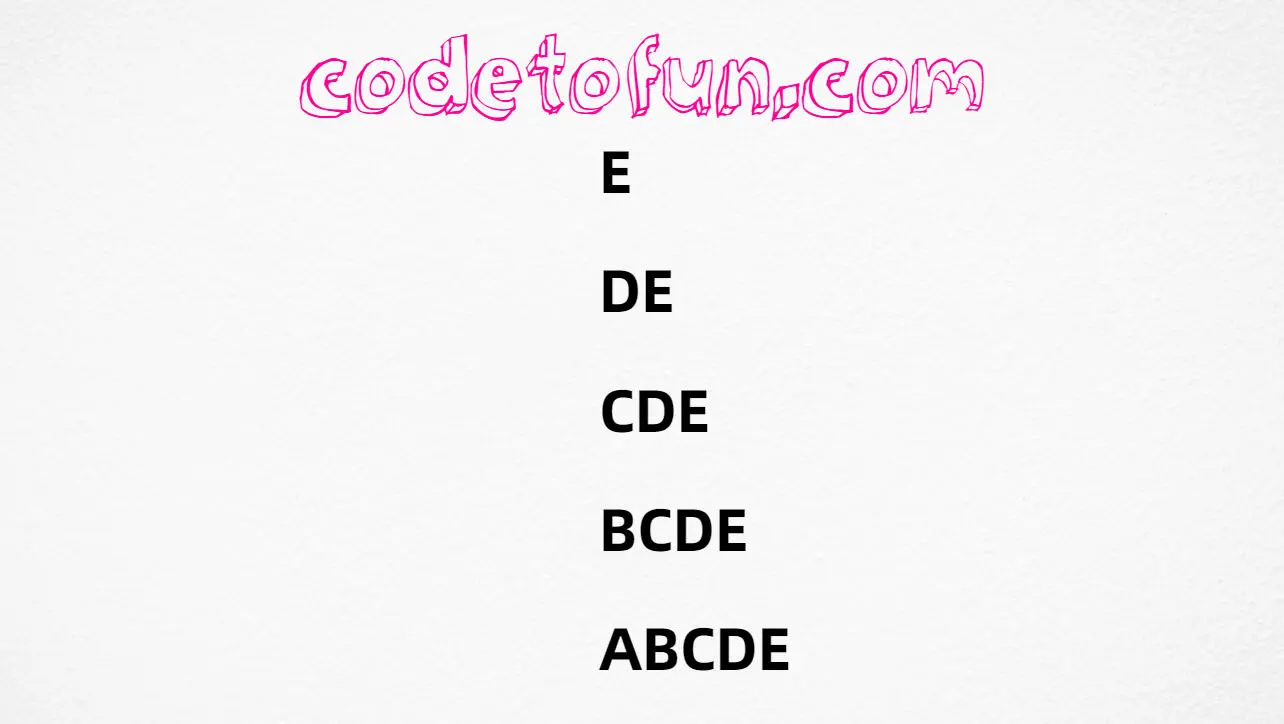
C Topics
- C Intro
- C Control Statement
- C Control Loops
- C String Functions
- C Math Functions
- C Header Files
- C Interview Programs
- C Star Pattern
- C Number Pattern
- C Alphabet Pattern
- Alphabet Pattern 1
- Alphabet Pattern 2
- Alphabet Pattern 3
- Alphabet Pattern 4
- Alphabet Pattern 5
- Alphabet Pattern 6
- Alphabet Pattern 7
- Alphabet Pattern 8
- Alphabet Pattern 9
- Alphabet Pattern 10
- Alphabet Pattern 11
- Alphabet Pattern 12
- Alphabet Pattern 13
- Alphabet Pattern 14
- Alphabet Pattern 15
- Alphabet Pattern 16
- Alphabet Pattern 17
- Alphabet Pattern 18
- Alphabet Pattern 19
- Alphabet Pattern 20
- Alphabet Pattern 21
- Alphabet Pattern 22
- Alphabet Pattern 23
- Alphabet Pattern 24
- Alphabet Pattern 25
- Alphabet Pattern 26
- Alphabet Pattern 27
- Alphabet Pattern 28
- Alphabet Pattern 29
- Alphabet Pattern 30
- Alphabet Pattern 31
- Alphabet Pattern 32
- Alphabet Pattern 33
- Alphabet Pattern 34
C Alphabet Pattern 3

Photo Credit to CodeToFun
C Alphabet Pattern 3
Here`s a program that prints the above alphabet pattern using C Programming:
#include <stdio.h>
int main() {
int n = 5; // Number of rows in the pattern
char startChar = 'E'; // Starting character
for (int i = 0; i < n; i++) {
char currentChar = startChar - i; // Current character in each row
for (int j = 0; j <= i; j++) {
printf("%c", currentChar + j);
}
printf("\n");
}
return 0;
}💻 Testing the Program
When you run the above program, it will print the following output:
E DE CDE BCDE ABCDE
🧠 How the Program Works
Let's break down the logic behind the code:
The pattern is a triangular pattern consisting of alphabets. Each row in the pattern contains a sequence of consecutive alphabets starting from a specific character and going up to 'A'.
- In the given code, we have a variable n which represents the number of rows in the pattern. In this case, n is set to 5.
- The starting character is defined as 'E' using the variable startChar.
- The outer loop runs from i = 0 to i < n and controls the number of rows in the pattern.
- Inside the outer loop, we have another loop, the inner loop, which is responsible for printing the characters in each row. It runs from j = 0 to j <= i, where i represents the current row.
- Within the inner loop, we calculate the currentChar by subtracting i from the startChar. This ensures that each row starts with the desired character and goes in descending order.
- Finally, we print the characters currentChar + j in each row, where j iterates from 0 to the current row index (i). This prints the consecutive alphabets in each row.
- After printing all the characters in a row, we move to the next line using printf("\n"), creating the triangular pattern.
It follows the pattern where the starting character 'E' is present in the first row, then in each subsequent row, the starting character decreases by one and the row contains consecutive alphabets up to 'A'.
💯 Tips for Enhancement:
Explore the versatility of this pattern by adjusting its parameters. Whether you increase or decrease the size, tweak the spacing, or modify the characters used, each change opens up a world of possibilities, allowing you to customize and create your unique visual effects.
✔ Conclusion:
Creating visually appealing patterns is not only a fun endeavour but also a great way to enhance your programming or design skills. We hope this tutorial has inspired you to explore the world of creative coding. Share your creations with us, and let your imagination run wild!
🤗 Closing Call-to-Action:
We'd love to see your unique interpretations of the alphabet pattern. Share your creations in the comments below, and don't hesitate to reach out if you have any questions or suggestions for future tutorials. Happy coding!
👨💻 Join our Community:
Author

For over eight years, I worked as a full-stack web developer. Now, I have chosen my profession as a full-time blogger at codetofun.com.
Buy me a coffee to make codetofun.com free for everyone.
Buy me a Coffee












If you have any doubts regarding this article (C Alphabet Pattern 3) please comment here. I will help you immediately.